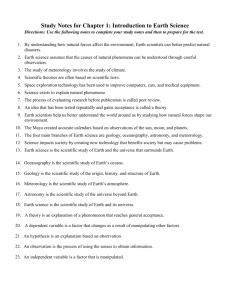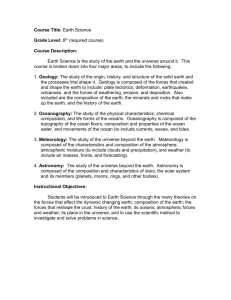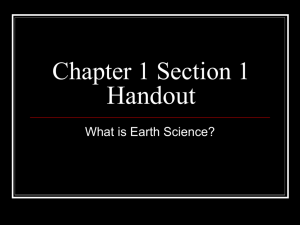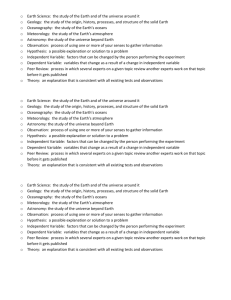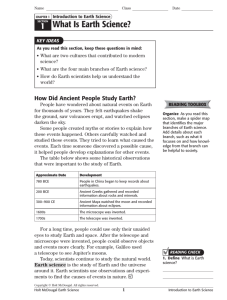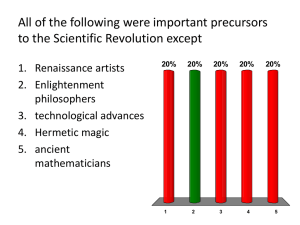Earth Science Chapter 1 – Introduction to Earth Science Section 1
advertisement
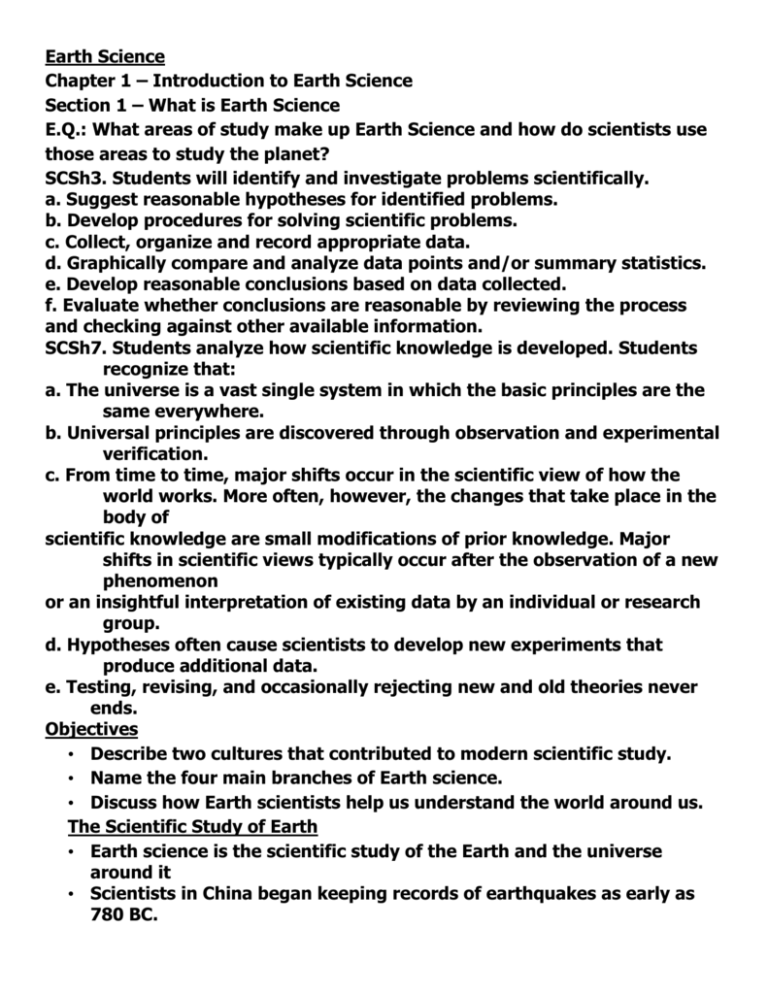
Earth Science Chapter 1 – Introduction to Earth Science Section 1 – What is Earth Science E.Q.: What areas of study make up Earth Science and how do scientists use those areas to study the planet? SCSh3. Students will identify and investigate problems scientifically. a. Suggest reasonable hypotheses for identified problems. b. Develop procedures for solving scientific problems. c. Collect, organize and record appropriate data. d. Graphically compare and analyze data points and/or summary statistics. e. Develop reasonable conclusions based on data collected. f. Evaluate whether conclusions are reasonable by reviewing the process and checking against other available information. SCSh7. Students analyze how scientific knowledge is developed. Students recognize that: a. The universe is a vast single system in which the basic principles are the same everywhere. b. Universal principles are discovered through observation and experimental verification. c. From time to time, major shifts occur in the scientific view of how the world works. More often, however, the changes that take place in the body of scientific knowledge are small modifications of prior knowledge. Major shifts in scientific views typically occur after the observation of a new phenomenon or an insightful interpretation of existing data by an individual or research group. d. Hypotheses often cause scientists to develop new experiments that produce additional data. e. Testing, revising, and occasionally rejecting new and old theories never ends. Objectives • Describe two cultures that contributed to modern scientific study. • Name the four main branches of Earth science. • Discuss how Earth scientists help us understand the world around us. The Scientific Study of Earth • Earth science is the scientific study of the Earth and the universe around it • Scientists in China began keeping records of earthquakes as early as 780 BC. • The ancient Greeks compiled a catalog of rocks and minerals around 200 BC. • The Maya tracked the movements of the sun, the moon, and the planets to create accurate calendars. • For many centuries, scientific discoveries were limited to observations of phenomena that could be seen with the unaided eye. • Earth science assumes that the causes of natural events, or phenomena, can be discovered through observation and experimentation. Branches of Earth Science • Scientists have used technology and hard work to build an immense body of knowledge about Earth. • Most Earth scientists specialize in one of four major areas of study: the solid Earth, the oceans, the atmosphere, and the universe beyond Earth. Geology • geology the scientific study of the origin, history, and structure of Earth and the processes that shape Earth • Geology includes many specialized fields of study, such as the study of earthquakes or volcanoes, exploration for natural resources such as coal and oil, and the study of Earth’s history through the study of rocks and fossils. Oceanography • oceanography the scientific study of the ocean, including the properties and movement of ocean water, the characteristics of the ocean floor, and the organisms that live in the ocean • Like geology, oceanography includes specialized fields. Some oceanographers study ocean water. Others study waves, tides, and ocean currents. Still others study the ocean floor or the organisms that live in the oceans. Meteorology • meteorology the scientific study of Earth’s atmosphere, especially in relation to weather and climate • Using satellites, radar, and other technologies, meteorologists study the atmospheric conditions that produce weather. They may use this information to prepare weather forecasts. • Some meteorologists study climate, the patterns of weather that occur over long periods of time. Astronomy • astronomy the scientific study of the universe • Astronomy is one of the oldest branches of Earth science. • Modern astronomers use Earth-based and space-based telescopes, as well as other instruments, to study the sun, the moon, the planets, and the universe. • How has technology affected astronomy? The development of telescopes, satellites, and space probes has greatly expanded astronomers’ understanding of the universe. Environmental Science • Environmental science is a relatively new field of Earth science that involves the study of the ways in which humans interact with their environment. • Environmental scientists study many issues, such as the use of natural resources, pollution, and the health of plant and animal species on Earth. The Importance of Earth Science • Natural forces not only shape Earth but also affect life on Earth. By understanding how natural forces shape our environment, Earth scientists can better predict potential disasters and help save lives and property. • The work of Earth scientists helps us understand our place in the universe. • The study of Earth science can help people gain access to Earth’s resources, and Earth scientists also strive to help people use those resources wisely.
